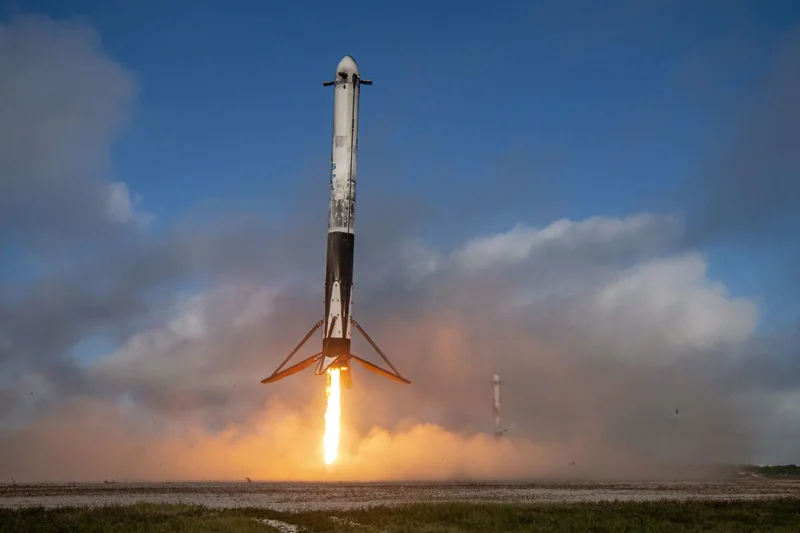The Two Faces of Commercial Space: One Launch is a Factory, The Other is a Boutique
In the span of about 12 hours this week, the commercial space sector gave us a perfect, almost clinical, case study in market divergence. On Tuesday night in California, a SpaceX Falcon 9 rocket, its fuselage scarred from 28 previous atmospheric reentries, roared to life for its 29th mission. It was a routine, almost mundane, delivery of 28 Starlink satellites. The next morning, in the West Texas desert, Blue Origin’s New Shepard rocket—sleek and comparatively pristine—carried six human passengers on a brief, elegant parabola to the edge of space and back.
On the surface, both were successful rocket launches. But looking at the data, it’s clear they weren't in the same business at all. One was an act of industrial logistics, a cog in a machine building a global communications network. The other was a meticulously crafted luxury experience. One is a factory; the other is a boutique. And the numbers tell a story of two companies with fundamentally different missions, metrics, and definitions of success.
The Relentless Assembly Line
Let’s start with SpaceX. The mission, Starlink 11-17, was notable for one primary reason: the booster, B1071, was on its 29th flight. This isn't a headline anymore; it's a data point in a trend line. The rocket lifted off, deployed its payload, and the first stage booster landed itself autonomously on a drone ship named ‘Of Course I Still Love You.’ This was the 516th successful booster landing for the company. SpaceX launches 28 Starlink satellites with a Falcon 9 booster flying for a 29th time – Spaceflight Now
These figures are staggering not for their novelty, but for their repetition. I've analyzed logistics chains for global shipping and manufacturing firms for years, and what SpaceX has achieved is less about the romance of rocketry and more about brutal process optimization. The product isn't the launch; the launch is the delivery mechanism for the product, which in this case is the Starlink constellation. Each launch is a marginal cost in a much larger business plan. The goal is tonnage to orbit, measured in cost per kilogram and launch cadence.
The entire operation feels like a well-oiled assembly line. The launch from Vandenberg occurred at 8:54 p.m. PDT. The satellites were confirmed in orbit less than four hours later. There was no manufactured drama, no mystery guests. The passengers were inanimate satellites, each one a node in a revenue-generating network. The booster’s previous missions tell the same story of utility: it’s lofted hardware for NASA and five missions for the National Reconnaissance Office. This is a workhorse, not a show pony.
The question this raises isn't whether SpaceX can do it, but how far this model can scale. We're watching a company vertically integrate an entire space-based industry in real-time. But what are the hidden costs of this relentless pace? What is the failure tolerance for a system that relies on components flying dozens of times more than any other orbital rocket in history? The data on long-term reusability is still being written, flight by flight.

The Curated Experience
Then you have Blue Origin’s NS-36 mission. It took off Wednesday morning after a couple of minor delays. It carried six people just past the Kármán line (the 100km altitude that marks the accepted boundary of space) for a few minutes of weightlessness before returning to Earth. This was the company’s 15th crewed flight since it began the service in 2021.
The numbers here tell a different story. The cadence is slower, about four to five crewed flights a year. The "payload" is the human experience itself. The entire event is framed not as a delivery, but as a performance. The most telling detail was the "mystery" sixth passenger. Blue Origin announced five of the names beforehand but kept the sixth anonymous until after the flight, revealing him to be Will Lewis, the CEO of Insmed (a biopharmaceutical company). Mystery rider joins 5 others in Blue Origin’s New Shepard launch
This isn't a logistical necessity; it's a marketing strategy. It generates articles, sparks online speculation, and adds a layer of curated exclusivity to the event. This wasn't the first time they've done this, either. It’s a feature, not a bug, designed to make the ticket—which requires a minimum deposit of $150,000—feel like an entry into a very exclusive club. The product is the view, the feeling of zero-g, and the story you get to tell afterward.
The entire operation is a high-end boutique experience. The passengers climb into a polished capsule named R.S.S. First Step. They are called "astronauts." The focus is on the comfort and thrill of the handful of people inside. But what is the actual business model here? Is suborbital tourism a self-sustaining market, or is it a very expensive, very public proof-of-concept for the company’s larger ambitions with its orbital New Glenn rocket? Is the manufactured drama of a mystery passenger a sign of savvy marketing, or a way to distract from a launch schedule that pales in comparison to its competitor's?
The contrast is stark. While SpaceX was deploying nearly 30 revenue-generating assets into a global network, Blue Origin was selling a handful of life-changing minutes to a few wealthy individuals. One is building infrastructure; the other is selling art.
The Metrics Define the Mission
Ultimately, these two events show us that the "commercial space race" is a misnomer. There is no single race. We’re watching two fundamentally different economic models playing out on different timelines. SpaceX is running a high-volume, low-margin (on a per-launch basis) logistics business. Its primary customer is itself. Success is measured in launch frequency, payload mass, and network uptime. Blue Origin is operating a low-volume, high-margin luxury goods business. Success is measured in ticket sales, brand prestige, and passenger safety. To compare them is to compare a freight train to a Ferrari. Both are triumphs of engineering, but they aren't going to the same place.









